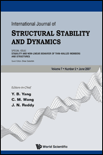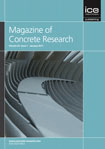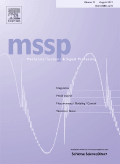
International Journal of Structural Stability and Dynamics
Scope & Guideline
Innovating the Future of Structural Engineering.
Introduction
Aims and Scopes
- Structural Dynamics:
The journal covers extensive research on the dynamic behavior of structures under various loading conditions, including vibrations caused by environmental factors, moving loads, and seismic activities. - Stability Analysis:
Research articles focus on the stability of structures under different conditions, including buckling analysis, post-buckling behavior, and the effects of imperfections and material properties. - Computational Methods:
The journal emphasizes the development and application of advanced computational techniques, such as finite element analysis (FEA), to model and analyze structural performance. - Smart Materials and Systems:
It includes research on the use of smart materials and adaptive systems that enhance the performance and resilience of structures under dynamic loads. - Health Monitoring and Damage Identification:
The scope includes methodologies for structural health monitoring, damage detection, and assessment techniques using modern technologies like machine learning and data-driven approaches. - Interdisciplinary Approaches:
The journal promotes interdisciplinary research that integrates insights from materials science, mechanics, and structural engineering to address complex challenges in structural stability and dynamics.
Trending and Emerging
- Machine Learning and AI in Structural Engineering:
The application of machine learning and artificial intelligence for predictive analysis, damage detection, and health monitoring is rapidly increasing, showcasing a trend towards data-driven methodologies. - Advanced Materials and Structures:
There is a growing focus on the use of advanced materials, such as functionally graded materials and smart materials, which offer enhanced performance characteristics in dynamic environments. - Seismic Resilience and Mitigation Strategies:
Research emphasizing seismic resilience, including the design and optimization of isolation systems and retrofitting techniques, has gained prominence due to the increasing frequency of seismic events. - Real-Time Monitoring and Adaptive Systems:
The trend is shifting towards real-time structural monitoring systems that utilize adaptive control methods to respond to dynamic loading conditions effectively. - Interdisciplinary Approaches to Structural Challenges:
A notable increase in interdisciplinary research that combines insights from various fields, such as mechanics, material science, and data analytics, to tackle complex structural challenges.
Declining or Waning
- Traditional Vibration Control Techniques:
There is a noticeable decline in research focused solely on traditional passive vibration control techniques, as newer adaptive and active methods gain prominence. - Simplistic Structural Models:
The use of overly simplistic structural models for dynamic analysis appears to be waning, with researchers favoring more complex and realistic modeling approaches. - Static Analysis in Isolation:
Research focusing exclusively on static analysis without considering dynamic effects is becoming less common, as the importance of dynamic interactions is increasingly recognized. - Empirical Studies without Computational Support:
There is a decrease in purely empirical studies that do not incorporate computational modeling or simulations, as the integration of technology becomes essential for comprehensive analysis.
Similar Journals

Journal of Structural Integrity and Maintenance
Championing Knowledge for Safer, More Efficient StructuresThe Journal of Structural Integrity and Maintenance, published by Taylor & Francis Ltd, serves as a prestigious platform dedicated to the advancement of knowledge in the fields of structural integrity, civil engineering, and materials science. With an ISSN of 2470-5314 and an E-ISSN of 2470-5322, this journal is uniquely positioned to address the critical challenges faced by researchers and professionals in building and construction, mechanical engineering, and related domains. Since its inception in 2016, this journal has been consistently recognized for its quality, currently holding a Q2 rank across several disciplines, including Building and Construction and Civil and Structural Engineering in 2023. The journal aims to publish high-quality research that contributes to the understanding and maintenance of structural integrity, fostering innovations that promote safety, efficiency, and sustainability in engineering practices. Researchers and students alike are encouraged to engage with this rich repository of knowledge, which plays a vital role in shaping future advancements in structural engineering and materials science.

Latin American Journal of Solids and Structures
Fostering Collaboration Across Engineering DisciplinesLatin American Journal of Solids and Structures is a premier, open-access academic journal dedicated to advancing the field of solid mechanics and structural engineering. Established in 2003 and published by LATIN AMER J SOLIDS STRUCTURES, this journal provides a vital platform for innovative research and scholarly discourse, with a particular focus on applications within aerospace, automotive, civil, and mechanical engineering as well as ocean and materials science. Recognized for its rigorous peer-review process, it has proudly earned a Q2 ranking in Automotive Engineering and maintains a presence in several Q3 categories, highlighting its impact and relevance in a wide array of engineering disciplines. With a commitment to accessibility and knowledge dissemination, the journal encourages contributions from researchers, professionals, and students alike, fostering collaboration and advancement in the rapidly evolving field of structural engineering and materials science. Located in São Paulo, Brazil, it serves as a bridge between Latin American scholars and the global research community.

Magazine of Civil Engineering
Building the Future: Research and Trends in Civil EngineeringMagazine of Civil Engineering, published by ST-PETERSBURG STATE POLYTECHNICAL UNIVERSITY, is a prominent open access journal dedicated to the field of civil and structural engineering. With an ISSN of 2712-8172 and E-ISSN 2071-0305, it serves as a vital platform for disseminating high-quality research, innovative methodologies, and current trends in building and construction. Since its inception in 2010, the journal has embraced open access, ensuring broad visibility and accessibility for its contributions to the academic community. The magazine holds a respectable position in the academic hierarchy, ranked in the Q3 quartile for both Building and Construction and Civil and Structural Engineering categories as of 2023. It is indexed in Scopus, amplifying its societal impact and reach with a rank of #114/223 in Building and Construction and #224/379 in Civil and Structural Engineering. Researchers, professionals, and students alike are encouraged to engage with the cutting-edge studies presented in the magazine, contributing to the advancement of knowledge and practice within the civil engineering domain.

Journal of Materials and Engineering Structures
Advancing Sustainable Engineering SolutionsJournal of Materials and Engineering Structures is a pioneering Open Access journal published by MOULOUD MAMMERI UNIVERSITY OF TIZI-OUZOU, dedicated to advancing the field of materials science and engineering. Since its inception in 2014, the journal has aimed to provide researchers, professionals, and students with a platform for sharing cutting-edge research and innovative applications in materials engineering and construction structures. Although the HIndex and Scopus ranking data are not specified, the journal plays a crucial role in disseminating knowledge that contributes to the development of sustainable and efficient engineering practices. With its commitment to accessibility and knowledge sharing in the heart of Algeria, the Journal of Materials and Engineering Structures is poised to make a significant impact on both local and global academic communities.

Journal of Vibroengineering
Connecting researchers to the pulse of vibrational research.The Journal of Vibroengineering, published by JVE INT LTD, stands as a pivotal open-access platform in the fields of Mechanical Engineering and Materials Science since its inception in 2008. With a focus on advancing the understanding of vibrational phenomena and their applications, this journal welcomes original research articles, reviews, and case studies that contribute to the body of knowledge in these dynamic areas. Based in Kaunas, Lithuania, the journal maintains high standards, securing a respectable Q3 quartile ranking in both Mechanical Engineering and Materials Science as of 2023, demonstrated by its Scopus rankings. By perpetuating access to valuable research without barriers since 2018, the Journal of Vibroengineering fosters a collaborative environment for researchers, professionals, and students alike, enabling them to stay at the forefront of interdisciplinary developments and innovations.

Opir Materialiv i Teoria Sporud-Strength of Materials and Theory of Structures
Exploring the Strengths of Materials for Safer StructuresOpir Materialiv i Teoria Sporud - Strength of Materials and Theory of Structures is a prestigious open-access journal published by BUDIVELNIK, focusing on significant developments in the fields of material science and structural engineering. Established in 2009, this journal facilitates the dissemination of original research articles, theoretical analyses, and case studies related to the strength of materials and structural stability. The journal aims to bridge the knowledge gap between academia and industry, fostering innovation and practical applications in construction and material technology. With its commitment to open access, Opir Materialiv i Teoria Sporud ensures that vital research is accessible to a global audience of researchers, professionals, and students, thereby contributing to the advancement of engineering practices and safety standards. The journal is based in Kyiv, Ukraine, and encourages rigorous academic discourse within its scope, making it an essential resource for those engaged in structural engineering and material sciences.

MAGAZINE OF CONCRETE RESEARCH
Transforming Ideas into Concrete InnovationsThe Magazine of Concrete Research, published by Emerald Group Publishing Ltd, is a pivotal journal in the fields of Building and Construction, Civil and Structural Engineering, and Materials Science, boasting an impressive track record since its inception in 1949. As of 2023, it holds a Q2 category ranking across its related disciplines, indicating its strong influence and credible contributions to the field with Scopus ranks placing it favorably among its peers. With an emphasis on advancing knowledge surrounding concrete technology and construction practices, this journal serves as a key resource for researchers, industry professionals, and students alike. Though not Open Access, the Magazine of Concrete Research continues to cut through the complexities of concrete-related innovations, inspiring advancements in both academic research and practical applications. Engage with the latest findings and technological developments in concrete research, ensuring you stay at the forefront of this essential field.

MECHANICAL SYSTEMS AND SIGNAL PROCESSING
Bridging critical fields to shape the future of technology.MECHANICAL SYSTEMS AND SIGNAL PROCESSING, published by Academic Press Ltd - Elsevier Science Ltd, is a leading journal that bridges multiple critical fields, including Aerospace Engineering, Civil and Structural Engineering, Computer Science Applications, Control and Systems Engineering, Mechanical Engineering, and Signal Processing. Established in 1987, this esteemed journal serves as an invaluable resource for researchers, professionals, and students seeking to advance the understanding of mechanical systems and their intimate relationship with signal processing techniques. With an impressive impact factor and consistently ranked in the Q1 category across various engineering and computer science disciplines, it offers rigorous peer-reviewed articles that contribute significantly to innovation and methodological advancements in the field. Although it does not currently offer Open Access options, its publication in the United States ensures a wide dissemination of high-quality research that shapes the future of engineering. The journal's convergence until 2025 promises to foster enduring discussions and collaborations that will continue to push the boundaries of technology and engineering applications.

JOURNAL OF ENGINEERING MECHANICS
Transforming Ideas into Engineering SolutionsJOURNAL OF ENGINEERING MECHANICS, published by the ASCE - American Society of Civil Engineers, stands as a premier interdisciplinary journal in the field of engineering mechanics. With an impact factor reflecting its vital contributions—placing it in the Q1 category for both Mechanical Engineering and Mechanics of Materials—this journal has established itself as a critical resource for researchers and professionals alike. Since its inception in 1981 and continuing through 2024, it has provided a platform for the dissemination of high-quality research, emphasizing innovative methodologies and cutting-edge findings. The journal's ranking in Scopus further underscores its significance, with impressive standings in the 79th and 77th percentiles of its respective categories. As a vital resource for students and professionals aiming to stay abreast of developments in engineering mechanics, it remains committed to fostering rigorous scientific exploration and practical applications within the field.

Revista Ingenieria de Construccion
Pioneering Insights in Building and Construction EngineeringRevista Ingenieria de Construccion is a prominent open-access journal dedicated to advancing knowledge and practice in the fields of building and construction engineering, as well as civil and structural engineering. Published by the Pontificia Universidad Católica de Chile, specifically the Department of Engineering and Construction Management, this journal has been providing free access to quality research outputs since 1986, ensuring that vital information is available to both practitioners and academics globally. With its current placement in the Q4 category of both the Building and Construction and Civil and Structural Engineering quartiles, it serves as a platform for innovative studies and critical discussions, positioning itself strategically within the academic landscape. The journal is indexed in Scopus, ranking #157 in Building and Construction and #291 in Civil and Structural Engineering, reflecting the growing impact and relevance of its contributions. Researchers, professionals, and students are encouraged to engage with the rigorous and diverse content published within its pages, fostering a vibrant academic and practical discourse.